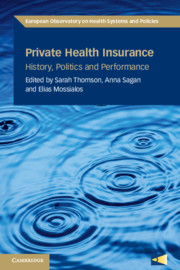67 results
Accelerating integration of social needs into mainstream healthcare to achieve health equity in the COVID-19 era
-
- Journal:
- Health Economics, Policy and Law / Volume 18 / Issue 1 / January 2023
- Published online by Cambridge University Press:
- 01 August 2022, pp. 82-87
-
- Article
- Export citation
Mental health and conspirasism in health care professionals during the spring 2020 COVID-19 lockdown in Greece
-
- Journal:
- Acta Neuropsychiatrica / Volume 34 / Issue 3 / June 2022
- Published online by Cambridge University Press:
- 10 December 2021, pp. 132-147
-
- Article
- Export citation
Clinical negligence cases in the English NHS: uncertainty in evidence as a driver of settlement costs and societal outcomes
-
- Journal:
- Health Economics, Policy and Law / Volume 17 / Issue 3 / July 2022
- Published online by Cambridge University Press:
- 02 July 2021, pp. 266-281
-
- Article
-
- You have access
- Open access
- HTML
- Export citation
Copyright page
-
- Book:
- Private Health Insurance
- Published online:
- 01 October 2020
- Print publication:
- 01 October 2020, pp iv-vi
-
- Chapter
-
- You have access
- Open access
- HTML
- Export citation
Contents
-
- Book:
- Private Health Insurance
- Published online:
- 01 October 2020
- Print publication:
- 01 October 2020, pp vii-viii
-
- Chapter
-
- You have access
- Open access
- HTML
- Export citation
Figures
-
- Book:
- Private Health Insurance
- Published online:
- 01 October 2020
- Print publication:
- 01 October 2020, pp ix-x
-
- Chapter
-
- You have access
- Open access
- HTML
- Export citation
Boxes
-
- Book:
- Private Health Insurance
- Published online:
- 01 October 2020
- Print publication:
- 01 October 2020, pp xiii-xiii
-
- Chapter
-
- You have access
- Open access
- HTML
- Export citation
Index
-
- Book:
- Private Health Insurance
- Published online:
- 01 October 2020
- Print publication:
- 01 October 2020, pp 552-574
-
- Chapter
-
- You have access
- Open access
- HTML
- Export citation
1 - Why private health insurance?
-
-
- Book:
- Private Health Insurance
- Published online:
- 01 October 2020
- Print publication:
- 01 October 2020, pp 1-40
-
- Chapter
-
- You have access
- Open access
- HTML
- Export citation
Acknowledgements
-
- Book:
- Private Health Insurance
- Published online:
- 01 October 2020
- Print publication:
- 01 October 2020, pp xiv-xiv
-
- Chapter
-
- You have access
- Open access
- HTML
- Export citation
Tables
-
- Book:
- Private Health Insurance
- Published online:
- 01 October 2020
- Print publication:
- 01 October 2020, pp xi-xii
-
- Chapter
-
- You have access
- Open access
- HTML
- Export citation

Private Health Insurance
- History, Politics and Performance
-
- Published online:
- 01 October 2020
- Print publication:
- 01 October 2020
-
- Book
-
- You have access
- Open access
- Export citation
Contributors
-
- Book:
- Private Health Insurance
- Published online:
- 01 October 2020
- Print publication:
- 01 October 2020, pp xv-xviii
-
- Chapter
-
- You have access
- Open access
- HTML
- Export citation
Assessment of technical errors and validation processes in economic models submitted by the company for NICE technology appraisals
- Part of
-
- Journal:
- International Journal of Technology Assessment in Health Care / Volume 36 / Issue 4 / August 2020
- Published online by Cambridge University Press:
- 03 July 2020, pp. 311-316
-
- Article
- Export citation
NICE's evaluations of medicines authorized by EMA with conditional marketing authorization or under exceptional circumstances
-
- Journal:
- International Journal of Technology Assessment in Health Care / Volume 36 / Issue 4 / August 2020
- Published online by Cambridge University Press:
- 25 June 2020, pp. 426-433
-
- Article
- Export citation
1 - Introduction
-
-
- Book:
- Challenges to Tackling Antimicrobial Resistance
- Published online:
- 21 March 2020
- Print publication:
- 23 April 2020, pp 1-22
-
- Chapter
-
- You have access
- Open access
- HTML
- Export citation
Figures
-
- Book:
- Challenges to Tackling Antimicrobial Resistance
- Published online:
- 21 March 2020
- Print publication:
- 23 April 2020, pp xi-xii
-
- Chapter
-
- You have access
- Open access
- HTML
- Export citation
Abbreviations
-
- Book:
- Challenges to Tackling Antimicrobial Resistance
- Published online:
- 21 March 2020
- Print publication:
- 23 April 2020, pp xv-xviii
-
- Chapter
-
- You have access
- Open access
- HTML
- Export citation
Foreword
-
- Book:
- Challenges to Tackling Antimicrobial Resistance
- Published online:
- 21 March 2020
- Print publication:
- 23 April 2020, pp ix-ix
-
- Chapter
-
- You have access
- Open access
- HTML
- Export citation
Acknowledgements
-
- Book:
- Challenges to Tackling Antimicrobial Resistance
- Published online:
- 21 March 2020
- Print publication:
- 23 April 2020, pp x-x
-
- Chapter
-
- You have access
- Open access
- HTML
- Export citation



